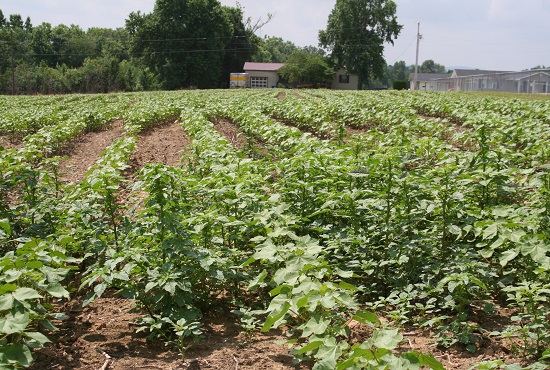Mediterranean Report: Textile Industry Positive Signs for Cotton in Mediterranean Mills
Once among the world leaders in yarn and textiles, the Mediterranean industry has been impacted by the shift of high volume production to Far Eastern countries. But it’s making a comeback, with a strong emphasis on quality and close proximity to markets in Europe.
A good example is Turkey. After a sharp decline in cotton yarn production from 810,000 tonnes in 2008 to 549,000 tonnes in 2009, production is forecast at 788,000 tonnes this year, with an increase of 20,000 tonnes to 808,000 tonnes projected for 2012.
Mill consumption of cotton is holding steady in Syria at 185,000 tonnes, down slightly (2,000 tonnes) in Italy to 52,000 tonnes and in Greece (1,000 tonnes) to 38,000 tonnes projected this year.
Production of cotton fabric declined in 2010 in Greece, Italy, and Spain (see table), but increased in both Egypt and France. The sharpest decline since 2008 in cotton fabric production occurred in Italy, from 112,500 tonnes in 2008 to 64,400 tonnes. Following are snapshots of the textile industry in Italy, Turkey, Egypt and Syria.
Made In Italy
Italy is the largest cotton consumer in the European Union, accounting for 24% of EU mill use. Italian cotton mill use declined slightly in 2010 to 54,000 tons, the smallest amount of cotton spun in the country since World War II. An important part of the cotton yarn-spinning activities have been relocated to other countries, but still are under Italian management.
As Monica Forti, former director of The SEAM, points out, the high price of raw cotton experienced last season is just one of the reasons for production declines. “The Italian economic environment still fights to find some stability and when cotton prices started to increase rapidly, textile companies preferred to downsize purchases and therefore production rather than putting their companies under a strong financial stress to maintain the same volumes under the new prices. These companies could not afford the risk to build and carry considerable stocks at high prices.”
The textile industry is combating imports from the Far East where high volume productions relocated with an emphasis on quality, exemplified by Made in Italy branding.
“Only the best quality items will be suitable for Made in Italy branding and fashion industry,” Forti says. “Some production lines will be better produced in the Italian plants as the quality/volume ratio will not make them suitable for large plant production located in the Far East.”
She believes, however, that cotton’s presence will remain paramount in Italy’s textile industry.
Back to Business in Egypt
The political unrest that enveloped Egypt earlier this year had a decided effect on movement of cotton. Traditionally, Egypt is a very competitive market, but from January through May, there was no activity. “But now Egypt is back with a vengeance,” says Rabih Farsoun, CEO and managing director of Cotton Trade International (CTI). “It is one of my biggest markets for yarn. We sell to mills producing all kinds of textiles for both local market and for export. We also buy yarn – fine counts from 40s up to 100 count – for export to Europe and to India. Egypt is definitely a major player. In recent months, volume of business has been high.”
Two pillars support the Egyptian textile industry: strong local demand and the export market, especially to the U.S. and Europe.
Unfortunately, one pillar might be somewhat shaky. As Farsoun explains, “The export market to the U.S. is governed by an agreement between Egypt, the U.S. and Israel called the QIZ (Qualified Industrial Zones) Agreement. QIZ provides duty-free and quota-free access to U.S. markets under the proviso that 11.7% of inputs used in the exported product is sourced in Israel. Any negative development in the political situation in Egypt and their agreement with Israel might jeopardize the QIZ Agreement. If that happened, 50% of Egypt’s textile industry would be affected. That is the issue that most concerns us.”
Syria May Move Towards Privatization
While the majority of Syria’s textile industry is government owned, it has allowed some investment in the private sector. There is some competition between the two sectors, but government pressures the private sector to produce different counts than produced at government-owned mills.
“Private mills only fill niches,” Farsoun says. “The government controls local cotton and decides what is released to private mills.” Syria owns a half-dozen or so very large mills, located in areas with chronic high unemployment. “Each mill employs 3,000 or 4,000 workers, when only 1,000 workers are needed,” he explains. “They lose money but the government is subsidizing them.”
Syria has not been impacted by political unrest in the area but the market is stagnant. “People are unable to buy,” Farsoun says.
“Prices have been high and they haven’t been in touch with the market to adjust to international prices. Also, there is a confidence problem. I’m afraid to commit myself to a buy contract when I’m not certain they will be able to get goods to port on time.”
As a result, the government mills have months of production in stock. “At each mill, we see 5,000, 6,000, up to 10,000 tonnes of yarn stored. This is creating high pressure because the new cotton crop is coming and they need cash to buy. Also, they are afraid to keep yarn in warehouses – if unrest escalates, there might be fires and other destruction,” Farsoun says.
“The mills have been very active. They want to sell but are not in touch with the market. Prices are being decreased, which is making Syrian yarn more attractive in the market place.”
Turkey Is Back in the Market
After what some have described as a “quiet period,” the Turkish textile industry is buying yarn. “It’s a big market for us,” Farsoun notes. “We sell a lot of yarn in Turkey from Syria, Pakistan, and Uzbekistan, even a little bit from India. Also finer counts from Egypt. Turkey is also back as a yarn seller, mainly with specific counts in the 40s.”
About 70% of Turkish imports originate in the U.S., primarily the result of the GSM-102 credit guarantees, actively used by Turkish buyers. This program covers credit terms to three years. GSM-102 underwrites credit extended by the private banking sector in the U.S. (or less commonly, the U.S. exporter) to approved foreign banks, using dollar-denominated, irrevocable letters of credit to pay for food and agricultural products sold to foreign buyers.
Salih Z. Dincbal, chairman of Baltas Yarn and Yarn Dyeing in Istanbul, describes textile companies in Turkey today as “careful and noncommittal,” buying only what they need for current production and putting very little in stock for future use. He cites the economic situation in Europe and abnormal price movements for their caution.
“Because of the sharp changes in cotton prices last year, some of the companies made profits but unfortunately some of them lost money – especially those who had high-priced raw cotton in their stocks,” he explains. “Companies who purchased raw cotton at low prices and sold yarn at high yarn prices made profits.”
He’s concerned about the economy and its effect on business. “Because of the price increases in organic raw cotton, traditional raw cotton and synthetics, there has been a decrease in demand. It impacts purchases because buyers are hesitant to commit when prices are increasing or decreasing sharply,” Dincbal explains.
And this hesitation is breaking the market, he believes, fueled in part by coverage of the current economic situation. “Negative reports or statements and speeches by people in authority and some media coverage have impacted the market,” he says. “Shrinkage of bank credit systems and increases in bank rates has also had a negative effect on trade.” Another reason why the GSM-102 program makes the U.S. an attractive supplier to Turkish importers.
Looking to the future, Dincbal says the key to success for Turkish mills is maintaining quality and providing quick service to European buyers. “This is our forte.”
Privatization On the Horizon
The economy and political unrest is sparking a growing interest in privatizing government-owned mills in Egypt and Syria. But other changes may be on the horizon. Rabih Farsoun points to the move of Uzbekistan into more yarn production and says emphatically,
“This should also be happening in Africa. Uzbekistan is beginning to produce yarn rather than exporting a million tons of cotton. Exporting is ridiculous. Uzbekistan has the manpower and investment funds, so why not spin more and get the economic benefits for the country? Even though Africa is producing so much cotton, we’re not hearing about mills being established.
“It’s been said that power may be an issue, but look at Pakistan, which has a huge power issue, yet all of the mills there have high power generation plants and are actually selling power to other industries. I hope it also happens in Africa.”








